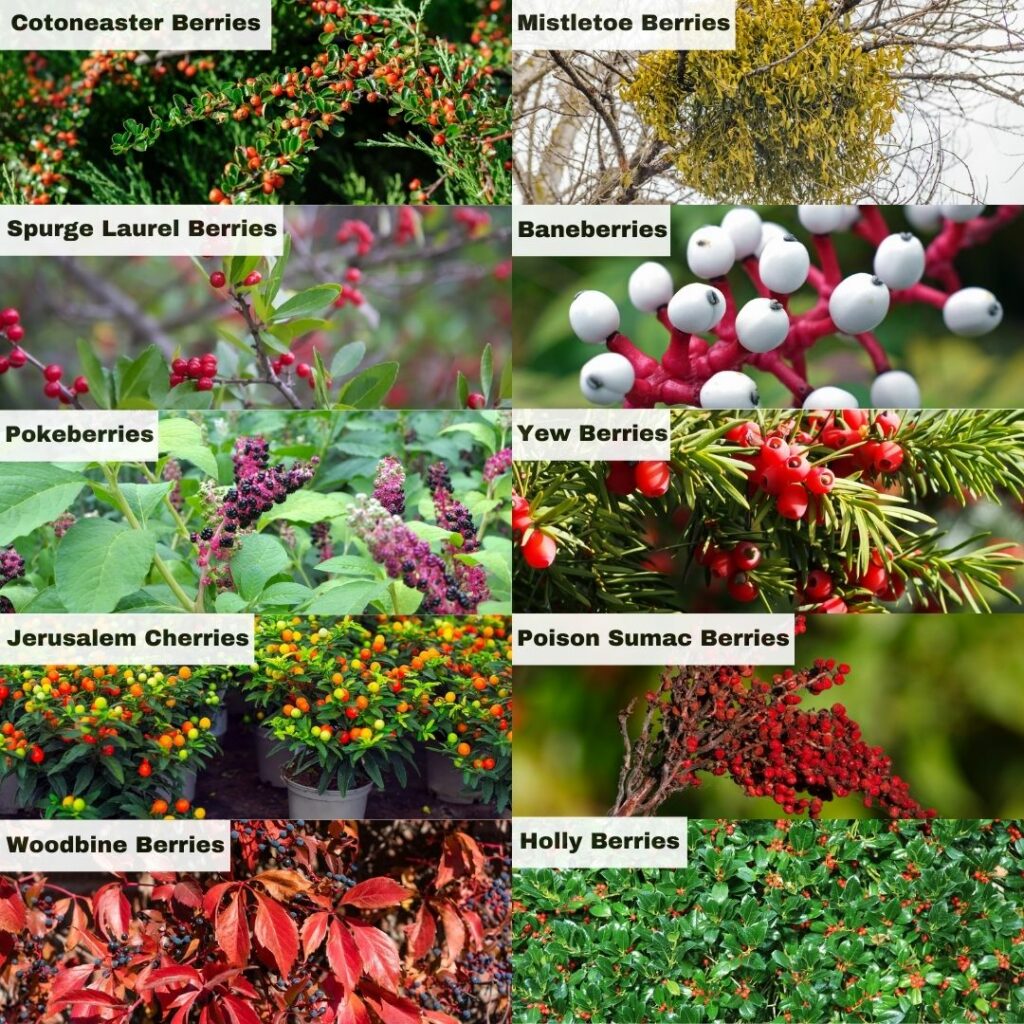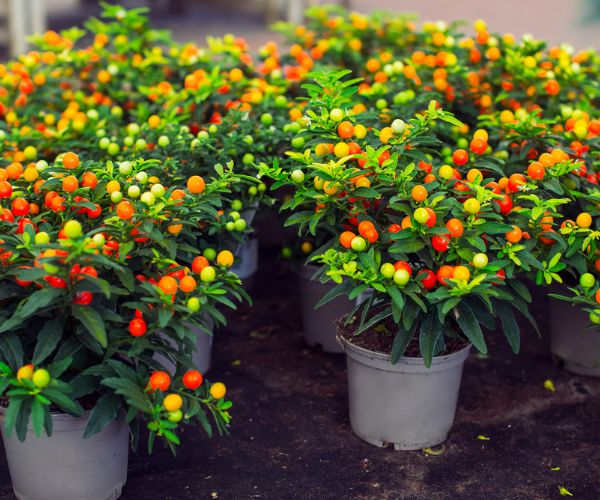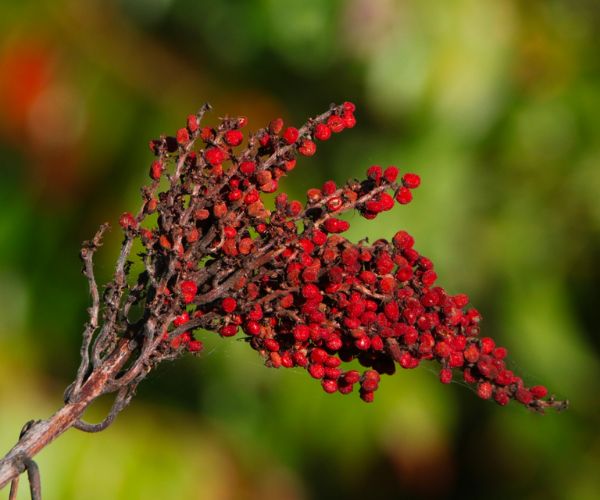Berries can save your life in a survival situation. Unfortunately, they can also kill you.
Not every berry is benign. Some will cause mild illness, while others can elicit severe reactions. Even berries that look tempting may be toxic, so it pays to know your stuff.
Luckily, I’m here to help you learn. Read on to discover 10 poisonous berries to avoid at all costs, so you can forage confidently and enjoy the fruits of your labor safely.
Poisonous Berries Chart

Poisonous Berries in Detail
1. Pokeberries

Pokeberries grow from the American pokeweed, or Phytolacca americana. This bushy perennial is native to the southeastern region of the US but has spread north to Canada and as far west as California. Pokeweed thrives on forest edges with a good mix of sun and shade, and mature plants can reach up to 10 feet tall.
Pokeweed has a green stalk and vibrant magenta shoots. It blooms with white or pink flowers in late spring, with purplish-black berries that ripen in autumn. The berries are arranged in cone-shaped clusters and hang heavily from the plant. They look a lot like delicious elderberries, but don’t be fooled. Pokeberries contain Phytolacca toxin and are an absolute nightmare on the gut.
Eating just a few can cause unpleasant symptoms like stomach upset, diarrhea, and vomiting. If you eat a lot or are particularly susceptible, you might experience dangerously low blood pressure, seizures, fainting, or even death.
Some people report boiling the leaves and eating them, but it’s not worth the risk. All parts of the plant are toxic.
2. Woodbine Berries

Woodbine is known scientifically as Parthenocissus quinquefolia, though you may also recognize it as Virginia creeper. It’s a common ornamental vine with beautiful green, red, and purple leaves. You’ll find woodbine berries across the central and eastern parts of the US and up into Canada.
Woodbine is prized for its fast growth. It climbs high and spreads far, flowering in late spring and quickly producing clusters of plump, purplish-black berries. The vine is technically a member of the grape family, and its berries look like tiny little grapes or blueberries. However, they are spaced further apart on the vine than grapes.
Virginia creeper berries aren’t so much poisonous as they are annoying. The leaves and berries contain oxalate crystals that irritate the mouth, lips, nose, and throat. They may produce more drastic symptoms like nausea, vomiting, diarrhea, and other gastrointestinal issues. These aren’t going to be fatal, but they will be unpleasant.
3. Jerusalem Cherries

Jerusalem cherries are beautiful, bushy little perennials. They flower in late summer and fruit in winter, so people often keep them as houseplants to impart cheer during gloomier months. They are an invasive species, escaping from pots to grow wild in parts of the southern US with adequate warmth and sunlight.
Known scientifically as Solanum pseudocapsicum, Jerusalem cherry plants are members of the nightshade family. This family includes tomatoes, peppers, and eggplants. Unfortunately, Jerusalem cherries look just as delectable as these nontoxic nightshades. But Jerusalem cherries are very poisonous.
They contain solanocapsine, a toxin that can cause severe gastrointestinal distress and affect the central nervous system. Symptoms include nausea and vomiting, with more severe cases leading to hallucinations, shock, paralysis, hypothermia, and death.
4. Yew Berries

The yew tree is a member of the Taxus genus, and its “berries” are some of the most dangerous around. Technically, a yew berry is an aril, a covering that protects the seed. The yew’s aril is not poisonous, but the seed inside it is. Since eating the aril without ingesting the seed is nearly impossible, they both land on the naughty list.
Yew seeds contain taxine compounds, which can potentially be fatal. You won’t just get a tummy ache from eating them. Symptoms include nausea, vomiting, coma, seizures, rapid vital decline, and even death in some cases.
Yews are evergreen conifers with thin needles instead of leaves. The bright red arils have a distinct, cup-like shape and mature in summer and fall. Many different varieties grow in the US, and almost every state will have one. Some yew trees are tall and grow wild in pine or deciduous forests. Others are shrubby and grow in ditches, rocky ravines, and mountainsides.
Even if yew doesn’t grow wild near your home, it’s not unheard of to encounter yew trees as decorative shrubs in gardens and landscaping. It can be hard to identify a yew tree because there are so many varieties, so always take special care when dealing with conifer fruits.
5. Mistletoe Berries

You might be kissing underneath it, but keep mistletoe out of your mouth. It’s a member of the Phoradendron family, literally translated from Greek as “tree thief.” This parasitic evergreen shrub seeks out weak conifers and hardwoods, nesting in their branches and stealing vital nutrients.
Ok, so it’s not purposely malevolent. But the popular Christmas plant and its beautiful, pea-sized berries are highly toxic. They contain phoratoxin and viscotoxin, which both have the potential for a serious reaction.
It’s important to note that there are over 1,300 varieties of mistletoe. Each contains different levels of these toxins, so the severity of the reaction will depend on the species.
Mistletoe is a versatile plant that grows throughout the US. Most species fruit in fall and winter, ripening to white or red. They look pretty tasty if you’re lost in the cold, but eating them will result in nausea and vomiting. You could also experience a more serious reaction, including blurred vision, severe bradycardia, hallucinations, and even miscarriage.
6. Holly Berries

American holly is another Christmas decoration you don’t want to put in your mouth. Known as Ilex opaca in the scientific community, this broad-leaved evergreen tree thrives in the Southeast and along the eastern seaboard. You may find it as far west as Missouri.
Holly prefers full sun, but you’ll also see it growing around shady forest edges and in nativity scenes nationwide. With distinct, sharpened leaves and a classic conical shape, holly is a very recognizable plant. Its small red berries ripen in late autumn and persist all winter.
Though we associate them with joy and cheer, holly berries are dangerous. They contain saponin, a poison that can cause nausea, vomiting, and abdominal cramping. In rare cases, people have reported drowsiness, hyperthermia, and severe skin reactions.
You’d have to eat quite a few berries to experience these effects as an adult, but children might have adverse reactions after just five berries.
7. Baneberries

With a name like baneberry, you know a plant has to be toxic. Red baneberry is known as Actaea rubra in the scientific world, while white baneberry is called Actaea pachypoda. Both are small perennial bushes that bloom in late spring, with flower racemes eventually giving way to clusters of waxy fruits that ripen in summer.
Both the white and red berries are ellipsoidal and thumbnail-sized, standing out with a distinct black dot at the end. Both baneberry varieties also have a far-reaching habitat and can be found all over the contiguous US, Canada, and as far north as Alaska. They can thrive in shady or sunny areas but prefer moisture and rain.
Baneberries contain ranunculin and produce a toxic protoanemonin that can cause throat burning, severe gastrointestinal distress, cramping, and hallucinations. If eaten in large quantities, baneberries will sedate the heart and can cause immediate cardiac arrest and death.
8. Cotoneaster Berries

Cotoneaster belongs to the Cotoneaster family and is a popular evergreen shrub for hedges and garden perimeters. It is an invasive species native to China with over 50 different varieties. Most cotoneaster species thrive in colder weather and are commonly found in the pacific northwest, but some can withstand warmer temperatures and grow as far south as Texas.
Cotoneaster has short round or oval leaves and long branches that may sometimes look treelike. It generally flowers with white blooms in the fall and fruits in the winter. The berries ripen to a vibrant red and grow in clusters on cotoneaster branches. They may grow so thick that they cover the entire shrub.
All types of cotoneaster berries are toxic. They contain compounds used to create cyanide, though you’d have to consume a lot to actually die from cyanide poisoning.
They’re much more likely to cause vomiting, cramping, and other gastrointestinal issues. In larger quantities, they may slow down breathing and induce seizures. It’s imperative to watch children around cotoneaster since the bright berries are very attractive.
9. Spurge Laurel Berries

Spurge laurel even sounds noxious. It’s an invasive species known scientifically as Daphne laureola, sometimes called daphne. Spurge laurel is native to northern Asia and Europe, thriving in higher elevations and colder climates. It was first introduced to the US as an ornamental evergreen shrub, but it has since escaped the confines of nurseries to wreak havoc on surrounding ecosystems.
Spurge laurel is banned in some places and highly controlled in others, but you’ll find it growing wild in northern parts of the US and various high-altitude zones. It can reach two meters high, with broad leaves arranged in a spiral formation around the stem.
It looks both wintry and tropical, a unique species that flowers with fragrant, light-hued purple or pink blooms.
Spurge laurel fruits in late winter, forming clusters of bright red, purple, or black berries. The berries and all other parts of the plant contain mezerein and other toxins that irritate the skin. If you eat them, you’ll likely experience symptoms such as blisters, skin rashes, and swelling of the lips, mouth, face, and throat. In severe cases, vomiting and gastrointestinal problems may occur.
10. Poison Sumac Berries

With over 250 varieties, sumac can be a confusing species. Most are small shrubs, but some grow into spindly trees over 30 feet high. Poison sumac, or Toxicodendron vernix, is more treelike than shrublike, though it can be stunted if soil quality is low.
Poison sumac grows in the southeastern United States and along the entire eastern seaboard, reaching as far west as Minnesota and even creeping up into Canada. It thrives on the banks of rivers, creeks, and lakes. It loves swampy, wet areas and needs a warm, humid climate to thrive.
Poison sumac has five to seven broad leaflets per stem and will bear white, flat-looking berries in the fall. This plant can be very dangerous if you eat it. It contains the toxic compound urushiol, which can cause an intense allergic reaction, including blisters and hives in the face, mouth, and throat. Severe gastrointestinal issues are possible.
Are you thinking twice about going out for a forage? Don’t be afraid. Just be cautious. Learn how to determine edibility when searching for wild food, so you can apply those principles next time you head outside. As long as you stay vigilant, you’ll stay safe and well fed.


Re: another ornamental and native holly is Yaupon Holly (Ilex Vomitoria)… vomit being the key word there… named by some European botanist a few hundred years ago from a ritual the Native Americans did by fasting then eating the red berries to throw up. Enough of that weirdness … but the leaves have a great amount of caffeine … the highest amount of caffeine of any native plant in North America…and was also used extensively by early settlers until the dummy above gave it an offensive name… and when dried and brewed it makes a fantastic tea. I find them growing wild while pack/tent camping all the time and I’ll harvest some to make tea and bring some home. Just don’t eat the red berries!!! They’re commonly used as ornamentals in flowerbeds and yards in the south… plant some and cultivate them … if teas and coffee become scarce or unavailable you’ll still have a resource for your morning cup of caffeine.
You CAN eat poke when it is very young. We ate it in greens with other wild plants that were safe to eat. It was something of a treat for our family. I also discovered that polk cab be fried, rather like okra. It’s quite tasty.
I had a cousin back in the ranch who got is pinky bit off by a copperhead i tell you what, never goin back in those woods! Rest in peace Earl.